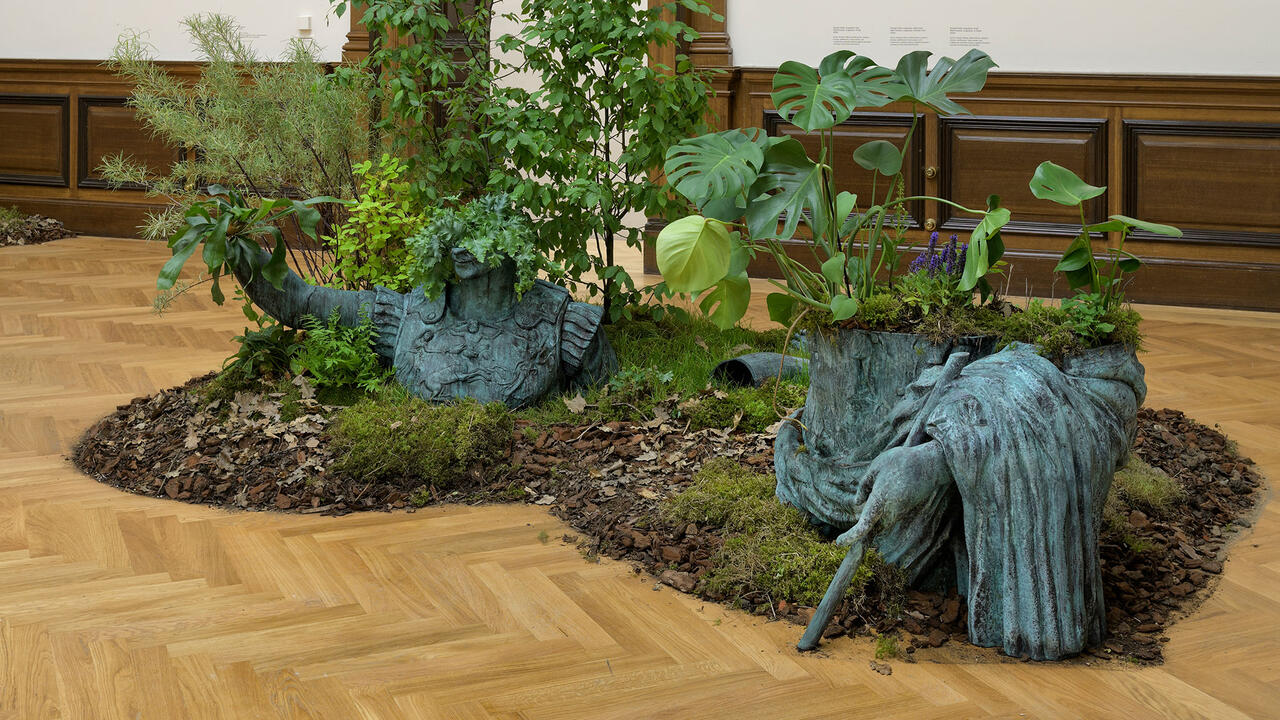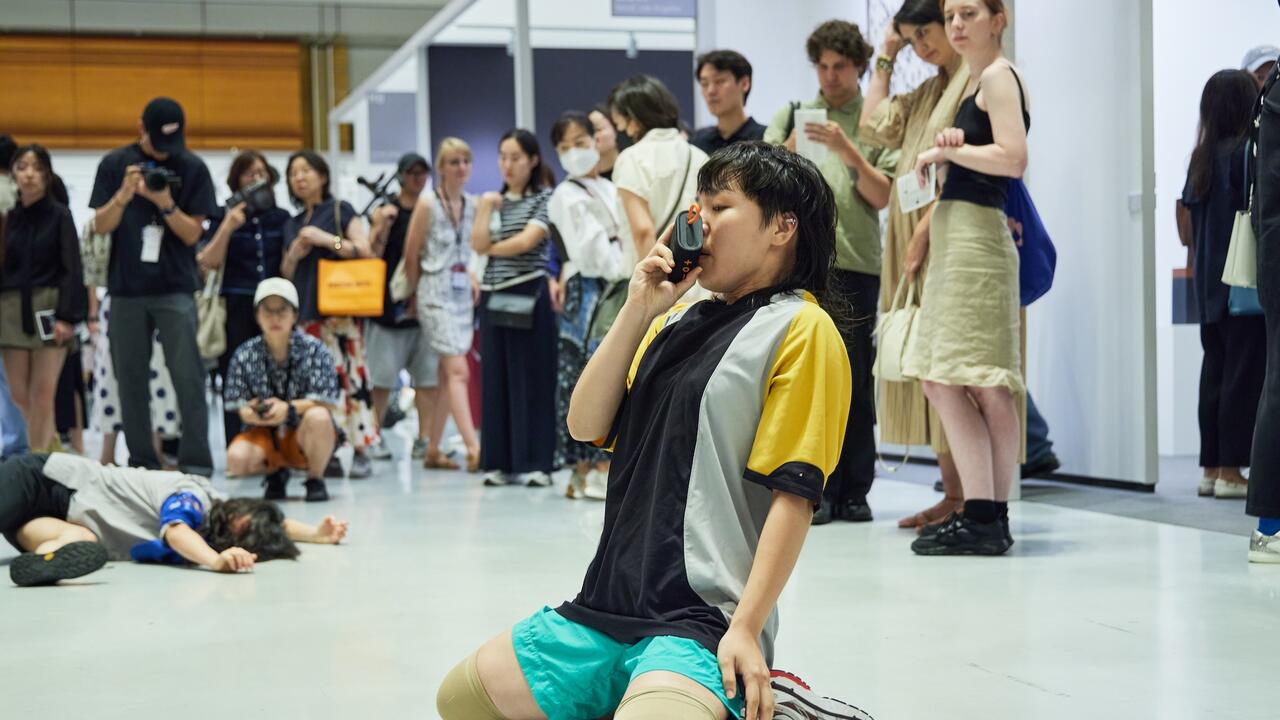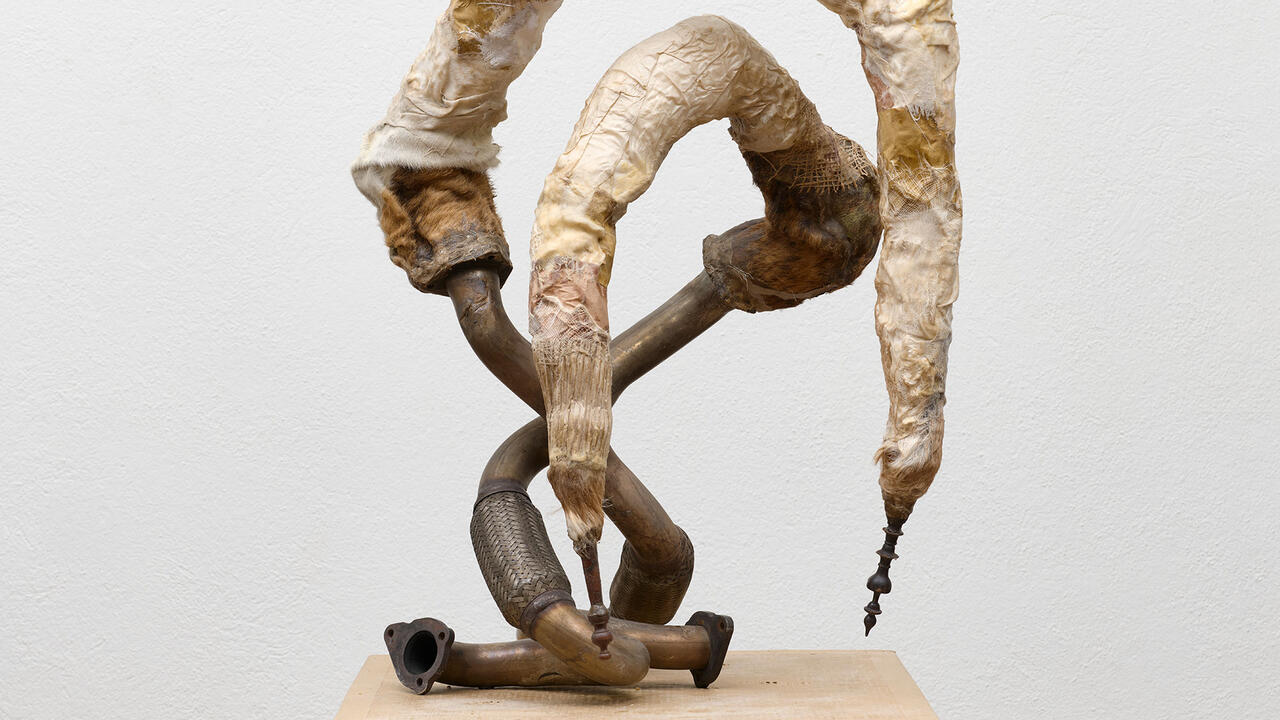The Darkness
Cameron Jamie
Cameron Jamie

Cameron Jamie has lived in Paris for several years now, a million miles from Northridge where he grew up in the 1970s and '80s. Northridge, a working and middle class district in the vast, undifferentiated suburban sprawl of the San Fernando Valley, was the epicentre of the earthquake in the Los Angeles area that caused $8 billion of damage in January 1994.
Much of it was destroyed, Jamie's apartment and studio included. For him, though, the earthquake was a godsend, forcing him finally to effect his egress from the neighbourhood he habitually describes - rather too literally - as a living hell.
Still, he can't keep away entirely. According to the artist, once a year he returns to Northridge wearing 'white face paint, a white shirt covered in fake blood, black cape, dark pants and a dark cape', though never around Halloween time. Once he reportedly 'walked into a supermarket limping like a hunchback'; another time he 'rode a white horse through the dark suburban streets of his old neighbourhood'.
We only have these words to go on: other than having a single witness accompany him on these visits, Jamie eschews all forms of documentation. The witnesses' 'testimonials' are in turn given to a commercial illustrator to interpret. Erik Weilhaert's ink drawings of Jamie's 'Goat Project' (2000-ongoing) fail as both art and documentation - stylistically they're bland, while the information they convey is vague. Two degrees of separation from the original performances, they look like they belong to a storybook one wouldn't give children. The three-stage process - performance, eyewitness account, illustration - simulates the process by which truth becomes myth through rumour, whose distortions and exaggerations result in dubious characters we can't wholly dismiss, such as the Limbless Witch of Northridge and the Decapitated Mexican Robber of the Valley. Jamie begins the 'Goat Project' an artist in a Halloween costume out of season. By the end he's Dracula cruising the valley. Apparently it happens all the time.
Jamie placed further obstacles between viewers and the original event last year, when he displayed the illustrations and testimonials from the 'Goat Project' along with a large number of his own characteristically scratchy, turbulent drawings in De Vleeshal, an art space in a Gothic hall in Middelburg in the Netherlands. To get to the drawings, visitors had to climb a concrete 'mountain' one by one, with only a lantern to light the way. On the other side they found the drawings hung from ropes slung around the necks of medieval statues. The melodrama of the viewing experience meant the project had come full circle, its performativity transferred from artist to viewer, and its content transplanted from the shadow of the film industry to its source in Gothic Europe.
Much of the time Jamie denies audiences access to the work. One of the 'Goat Project' illustrations shows the artist as Dracula burying boxes in the mountains overlooking the valley. The boxes, it transpires, contain videotapes and photographs of a number of performances hardly anyone witnessed. These took the form of fights with various adversaries enacted in apartments, mainly in Los Angeles. Just two have survived the burial: The New Life (1996), a contest with a Michael Jackson impersonator whom Jamie regularly encountered outside the Hollywood Wax Museum, and La Baguette (1997), which documents a bruising two-hour tussle with an ex-con who worked in the canteen at the art school in Bordeaux. Both feature Jamie in his usual wrestling outfit: full-body white underwear, a novelty shop rubber arse and a mask based on his own features, commissioned from a wrestling mask maker in Mexico in 1992.
Jamie's private bouts are an outcome of his fascination with professional wrestling, a pursuit that dates back to his childhood. Wrestling, as Roland Barthes contends in his essay 'The World of Wrestling' (1952), is an iconographic spectacle that has little relationship with sport. Jamie's interpretation is somewhat similar: he regards it as a form of working-class opera: a mythic arena of heroes and villains, of good versus evil. For Jamie that arena was downtown LA's Olympic Auditorium. Its most legendary protagonists - among them Moondog, Gorgeous George and The Hangman - made the antics of Alice Cooper and Ozzy Osbourne seem tame. At ringside, on every occasion, weathering volleys of beer, urine and abuse from the crowd, was the stoic figure of Theo Ehret, the Olympic's in-house photographer from the 1950s to the 1980s. Years later Jamie acquired all Ehret's negatives - several thousand in total. Eventually a fraction of this archive was the subject of a colossal Taschen publication, Exquisite Mayhem: The Spectacular and Erotic World of Wrestling by Theo Ehret (2001), which Jamie assembled with Mike Kelley. When sales of wrestling magazines began plummeting in the 1970s, Ehret started taking pictures of naked or near-naked hippie girls wrestling in apartments, inaugurating a pornographic subgenre by default. Sales of the book were brisk in both art bookshops and sex shops.
The sport's governing body, the World Wrestling Federation (WWF), made wrestling mainstream, but it also gave rise to a new grassroots phenomenon. Backyard (as opposed to apartment) wrestling involves kids, mostly male and in their teens, emulating the identities and moves of their television heroes in makeshift wrestling rings, with improvised costumes and props, in suburban backyards. In the late 1990s Jamie made the acquaintance of kids involved in the scene in the valley, and began filming them applying face paint, rehearsing moves, staging fights and hanging around. Eventually he abandoned the 50 or so hours he'd accumulated, deciding instead to make a film in a single afternoon, shot in black and white Super 8, and edited in-camera. The result, BB (2000), is mesmeric, and as formal as it is intense. It became the first of a triptych of films featuring an original soundtrack by The Melvins, whose monolithic, Deconstructionist rock was the perfect counterpart to Jamie's dark celluloid anthropology. The triptych was premiered at the Forum in London by Artangel in November last year - together, the films and The Melvins live were electrifying.
Like BB, Spook House (2003) is the outcome of almost a lifetime's work. Since his early teens Jamie has been photographing the elaborate and macabre tableaux that spring up all over the valley at Halloween. For Spook House he went to Detroit, where suburban disaffection, if anything, runs even deeper. We see front lawns that have been turned into grizzly cemeteries and cellars that are now death row penitentiaries. A modest entrance fee admits one to the 'Fear Factory Haunted Hayride', the 'Chamber of Torture' and the 'Cannibal Cafeteria' - where 'manburgers' are served and a human arm roasts on a BBQ. Technically these vernacular installations can be astonishing: hydraulics cause corpses to sit up, pulleys make a ghost glide through the air on wires, and an old sedan holding a bloody crash victim fills with smoke. Everywhere there are kids or mannequins dressed as vampires, zombies, werewolves, witches, aliens, leering clowns, disembodied heads, headless bodies, Freddie Krugers, Frankensteins and Osama bin Ladens. Black and white segments make some of these scenes resemble the early horror films that inspired them, while colour sequences return one to the prosaic reality of the suburban backdrop. Midway through the film multiple exposures and rapid cuts produce a frenzy of gore and latex; you forget for a moment that what you are looking at is contemporary Michigan; the effect is hallucinatory and archaic, like a voodoo ceremony. In his Parisian studio overlooking the Seine, Jamie remarked, 'America is the Primitive; the USA is the Third World. In Africa they used wood for masks; in American suburbs they use rubber and latex.'
Jamie makes little distinction between Old and New World rituals, which he regards as expressions of the same human impulses. For Kranky Klaus (2003), the final part of the triptych, he filmed an ancient Austrian custom that persists in rural areas. Each year, on 6 December, a group of men dress up in 19th-century costumes, handed down through families, portraying a mythical beast known as the Krampus, half man and half mountain goat. They are accompanied by St. Nicholas, wearing papal mitre and cope, along with a couple of rustic helpers bearing baskets of gifts. Whereas Santa rewards, the Krampus' job is to punish, usually through physical assault. 'Kranky Klaus' follows the progress of the Krampus figures around Bad Gastein at night through restaurants, bars, hotels, a Southern Confederate-themed clubhouse and a Shell garage. Like the Olympic Auditorium wrestlers and the spook houses, the Krampuses amuse and terrify onlookers in equal measure and in quick succession. One moment they dance a comic jig that makes their oversized cowbells resound; the next someone is close to getting their eyes gouged out by one of the four long horns that protrude from their monstrous face masks.
Jamie's forthcoming project, in collaboration with legendary Japanese electronic maestro Keijo Haino, also mines European legends. He plans to make a film of the annual re-creation in Orléans of the martyrdom of Joan of Arc, played by a teenage virgin in full body armour. Accused of being a heretic and a witch on account of her schizophrenia and androgyny, Joan was burnt at the stake by the citizens she saved from the English. Of late she has become an icon for the right wing in France - each year they gather around a golden statue of her in Paris. The origin of Joan of Arc for Cameron Jamie wasn't Orléans or Paris, however, but Northridge. He first heard the name 'Joan of Arc' from a schoolteacher who ritually frequented a certain hamburger stall in the valley because of their extra-crispy French fries. They did them 'Joan of Arc style'.















